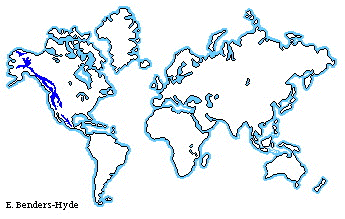


Plants Animals Climate Return to
Alpine The Rocky Mountains
are located in western North America. They are know for
their beautiful scenery with mountains, trees and big game.
People visit the Rockies for many recreational activities
like hiking, hunting, camping, skiing and lots of other
sports. The Rocky Mountains
have unpredictable weather which can change rapidly. As with
other highland climates, the climate changes with increasing
altitude. In general, the Rockies have mild summers, cold
winters and a lot of precipitation. The Rockies have
very different seasons. In the winter there is deep snow,
high winds, and sudden blizzards are common. At night it can
get to -35û F or below! In the spring there is unpredictable
weather. It could be wet or dry, cold or warm. In the summer
there are sunny mornings, afternoon thunderstorms and clear
nights. In the fall there are cool, crisp days, wind and
decreasing precipitation. There is lots of
vegetation. The forests are full of pine trees, firs and
spruces.Plants are very sturdy, most clinging to rock or
hard soil. Some adaptions that
animals have made to the climate is that the hoofed species
are very surefooted for the mountainous terrain they live
on. Many animals migrate to lower and warmer elevations
during the winter months. Some animals shed their brown fur
to replace it with white so that they blend in with the
snow. Some hibernate and some even have big feet so that
they can walk on snow. Koppen's letter code
that describes the Rockies are H, Csb and Cfc. H means
highland climate. C means warm temperature climate. s means
dry season in summer. f means sufficient precipitation in
all months. b means warmest month mean under 71.6û F. c
means fewer than four months with means over 50û
F. The average
temperature per year is 43û F. For Winter the average
temperature is 28û F. 40û F is the average Spring
temperature. In the Summer 59û F is the average temperature
and for Fall it is 44û F. The highest temperature is 82û F
in July. The lowest temperature is 7û F in
January. The average
precipitation per year is 14 inches. The average for winter
is 1.4 inches. The average precipitation for the season of
spring is 4.2 inches. For summer it is 5.9 inches and for
fall it is 2.6 inches. In the winter there are some
snowstorms and blizzards. It snows later in the fall and
there is decreasing precipitation. There is a lot of thunder
and lighting in the summer. It rains and snows in the
spring. The latitude and
longitude range is 35û N to 60û N, and 115û E to 165û E.
The Rocky Mountains
are rich in environmental treasures. Conservation and
protection is important to make sure the Rockies are just as
wonderful as they are today for many generations. by Hilary D.
2003
bibliography: Photo by Andrey
Narkevich Hubbard, Fran.
Animal Friends of Yellowstone. Texas: Awani press,
1971. Kalman, Bobbie.
What is a Biome. New York: Crabtree publisher, 1988.
"Rocky Mountain."
World Book. 2000 ed. "Rocky Mountain
National Climate." http://www.us-parks.com/US_National_Parks/rocky/rocky_climate.shtml "Rocky Mountain
National Park Climate Information." http://www.rmnp.com/RMNP-Planning-ClimateInfo.HTML "Rocky Mountain
National Park Weather." http:www.explore-rocky.com/weather/default.htm
(11 Dec. 2002) Strahler, Arthur N.
and Strahler, Alan H. Elements of Physical Geography.
New York: John Wiley and Sons, 1984.
(11 Dec. 2002).
(11 Dec. 2002).